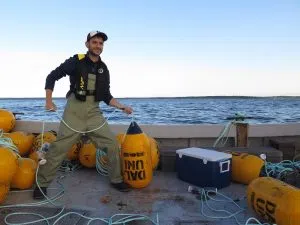Shelburne residents may be wondering next week why their harbour is dotted with orange buoys.
Dalhousie University and the Department of Fisheries and Oceans have partnered to map nutrient sources from fish farms and sewage facilities in the area.
Project Lead Dr. Leigh Howarth says seaweed will be placed in jars and suspended below the buoys to absorb nutrients.
“There are no scientific instruments on there. There is nothing that’s causing any harm to the marine environment. There’s also nothing of value, either. Even if it’s kind of inconvenient and you have to navigate around the buoy, I would really appreciate it if no-one was to interfere with the buoys themselves.”
Howarth says a line below the buoys holds peanut butter jars containing seaweed which absorb nutrients out of the water.
He wants the community to be aware of what they’re doing.
“I don’t want them to just wake up and find 50 giant yellow buoys clogging up their bay and then not have any idea why. I also don’t want the lobster fisherman to think that this is going to get in their way come November 30 when they start fishing, because we’re going to remove the buoys before then.”

Dr Leigh Howarth prepares buoys. Photo Credit: Dr Leigh Howarth October 2019
Howarth says increasing human activity around coastlines requires a better way of measuring the impacts of those activities.
A similar study conducted last year in Liverpool revealed how nutrients from several man-made sources traveled in the water.
Howarth looks forward to applying his techniques in the larger, Shelburne Harbour.
He stresses, the buoys will be in the water for two to three weeks and will be removed before the start of lobster season.
Reported by: Ed Halverson
Twitter: @edwardhalverson
E-mail: halverson.ed@radioabl.ca









